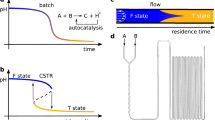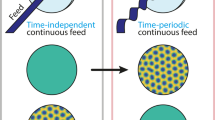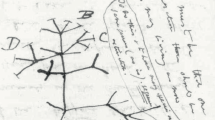Abstract
IN his classic 1952 paper, Turing1 suggested a possible connection between patterns in biological systems and patterns that could form spontaneously in chemical reaction–diffusion systems. Turing's analysis stimulated considerable theoretical research on mathematical models of pattern formation, but Turing-type patterns were not observed in controlled laboratory experiments until 19902,3. Subsequently there has been a renewed interest in chemical pattern formation and in the relationship of chemical patterns to the remarkably similar patterns observed in diverse physical and biological systems4. Numerical simulations of a simple model chemical system have recently revealed spot patterns that undergo a continuous process of 'birth' through replication and 'death' through overcrowding5. Here we report the observation of a similar phenomenon in laboratory experiments on the ferrocyanide–iodate–sulphite reaction. Repeated growth and replication can be observed for a wide range of experimental parameters, and can be reproduced by a simple two-species model, suggesting that replicating spots may occur in many reaction–diffusion systems.
This is a preview of subscription content, access via your institution
Access options
Subscribe to this journal
Receive 51 print issues and online access
$199.00 per year
only $3.90 per issue
Buy this article
- Purchase on Springer Link
- Instant access to full article PDF
Prices may be subject to local taxes which are calculated during checkout
Similar content being viewed by others
References
Turing, A. M. Phil. Trans. R. Soc. B327, 37–72 (1952).
Castets, V., Dulos, E., Boissonade, J. & De Kepper, P. Phys. Rev. Lett. 64, 2953–2965 (1990).
Ouyang, Q. & Swinney, H. L. Nature 352, 610–612 (1991).
Cross, M. C. & Hohenberg, P. C. Rev. mod. Phys. 65, 851–1112 (1993).
Pearson, J. E. Science 261, 189–192 (1993).
Lee, K. J., McCormick, W. D., Ouyang, Q. & Swinney, H. L. Science 261, 192–194 (1993).
Gáspár, V. & Showalter, K. J. phys. Chem. 94, 4973–4979 (1990).
Reynolds, W. N., Pearson, J. E. & Ponce-Dawson, S. Phys. Rev. Lett. 72, 2797–2800 (1994).
Zaikin, A. N. & Zhabotinskii, A. M. Nature 225, 535–537 (1970).
Winfree, A. T. Science 175, 634–636 (1972).
De Kepper, P., Perraud, J. J., Rudovics, B. & Dulos, E. Int. J. Bifurcation Chaos (submitted).
Petrich, D. M. & Goldstein, R. E. Phys. Rev. Lett. 72, 1120–1123 (1994).
Hagberg, A. & Meron, E. Phys. Rev. Lett. 72, 2494–2497 (1994).
Author information
Authors and Affiliations
Rights and permissions
About this article
Cite this article
Lee, KJ., McCormick, W., Pearson, J. et al. Experimental observation of self-replicating spots in a reaction–diffusion system. Nature 369, 215–218 (1994). https://doi.org/10.1038/369215a0
Received:
Accepted:
Issue Date:
DOI: https://doi.org/10.1038/369215a0
This article is cited by
-
Self-replicating segregation patterns in horizontally vibrated binary mixture of granules
Scientific Reports (2024)
-
Arbitrarily weak head-on collision can induce annihilation: the role of hidden instabilities
Japan Journal of Industrial and Applied Mathematics (2023)
-
Recent advances in the temporal and spatiotemporal dynamics induced by bromate–sulfite-based pH-oscillators
Reaction Kinetics, Mechanisms and Catalysis (2022)
-
Nonlinear Galerkin finite element methods for fourth-order Bi-flux diffusion model with nonlinear reaction term
Computational and Applied Mathematics (2020)
-
Mathematical modelling and simulation of microbial carbonate precipitation: the urea hydrolysis reaction
Acta Geotechnica (2020)
Comments
By submitting a comment you agree to abide by our Terms and Community Guidelines. If you find something abusive or that does not comply with our terms or guidelines please flag it as inappropriate.



